
Donington, England: The longest of Matthew Flinders’ many epic journeys is finally on its home stretch.
As the first person to circumnavigate Australia and the explorer who popularised its name, Flinders has long been a figure of national importance. There is no major city that does not, in some way, bear his name.
A mountain range, one of the main streets of Melbourne, two national parks, and a university, among many other things, are named in his honour. In Sydney, they even built a statue of his beloved cat and fellow traveller, Trim.
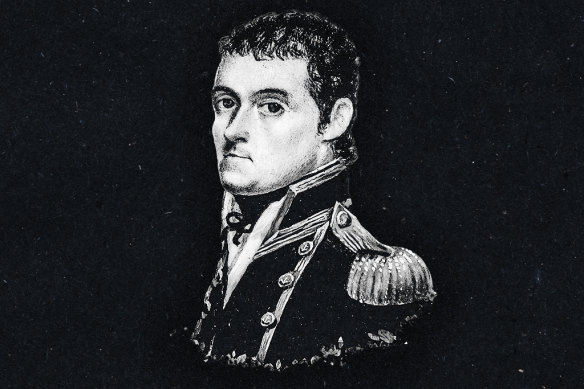
Matthew FlindersCredit: Marija Ercegovac
But in his native Britain, the navigator and cartographer remains largely forgotten, despite a life story that could almost compete with Robinson Crusoe, the novel he read as a child that inspired him to seek life at sea.
And now, two centuries after his death, Flinders is finally returning to the village in rural England where he was born 250 years ago on March 16. On July 13, the people of Donington, Lincolnshire, will bury his remains, which were discovered in an archaeological dig at London’s Euston station five years ago, in the church where he was baptised as a child.
Royal Navy pallbearers will carry his bespoke coffin, draped in a special standard of half Union Jack and half Australian flag, to its final resting place inside St Mary and the Holy Rood, the 13th-century parish church built of limestone ashlar. Inside the cold, damp and musty church is a stained-glass window tribute to Flinders, gifted by the Australian federal and state governments 40 years ago.
“I mean where else should he come but here,” says Jane Pearson of the Matthew Flinders Bring Him Home group, a collection of Donington locals who for years have fought for him to be better known in his homeland.
“Once they found the body, we had the opportunity to give him his due tribute after all of these years … we had no option but to do it. And once the Flinders family were on board, we have spent the past few years trying to make it happen.”
Pearson – who was born and bred in Donington and retired from a career in insurance, only to become busier running several community groups in the village – points in the general direction of several graves inside the churchyard. Flinders’ father Matthew Snr, the village surgeon, was buried in the church grounds as were his brother, Samuel, his grandfather John and various aunties.
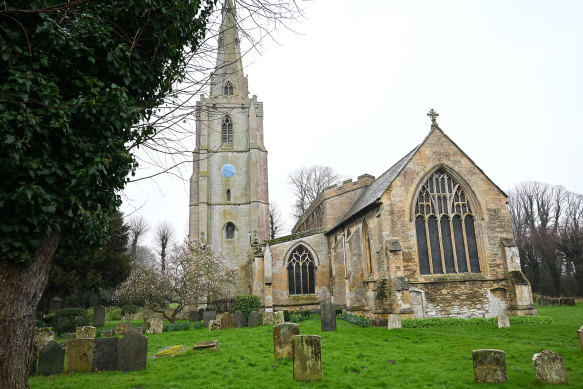
St Mary and the Holy Rood, the church where Matthew Flinders will be reburied. Credit: Toby Roberts
“But of course, to dig the church floor, you have to get permission from the higher echelons of the church, but then of course, COVID came along.”
“It is actually the first burial within the church since the 19th century,” Pearson says. “We have had a splendid black marble ledger stone made, at huge expense, but we have been lucky enough to have some benefactors and a grant from the government.”
Donington – about 2½ hours drive north of London, near the market town of Spalding – is somewhat of a living museum to Flinders. He attended the local grammar school until he was 12 and then, when his father discovered his obvious intellect, was sent to a school in Horbling, west of the village, until he was 15.
The family home, at the joining of Market Place and Station Street, was demolished in 1908. But the new red brick home built in its place has a plaque alongside the front door recording that on this site, “Matthew Flinders – Explorer” was born. On the anniversary of his birthday in 2006, a bronze life-size statue was unveiled just 50 or so metres from his birthplace. The local school has a house named in his honour, as is a local park.
Determined to embark upon a life of exploration, young Flinders left Donington against his father’s wishes to enter the navy as a teenager in 1789. In 1791, he served under William Bligh, fresh from mutiny on the Bounty, as midshipman on a voyage to Tahiti and, returning to England, saw action on HMS Bellerophon at the naval battle of the Glorious First of June in 1794 – the first and largest fleet action of the naval conflict between Britain and France during the French Revolutionary Wars.
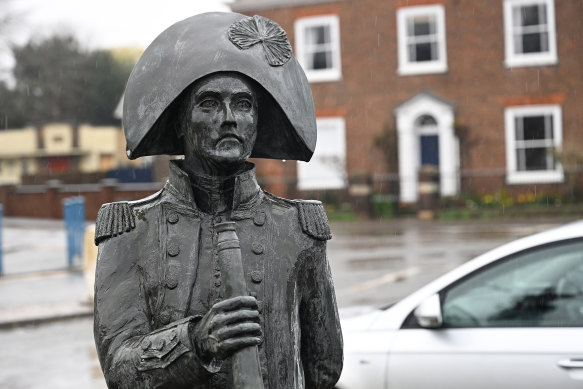
The bronze statue of Flinders in Donington unveiled in 2006, about 50 metres from his birthplace.Credit: Toby Roberts
From there, still in his 20s and in the company of George Bass, he circumnavigated Van Diemen’s Land and for the first time proved it was an island. In March 1800, he sailed for England in the Reliance, where reports of his outstanding ability had preceded him.
He died aged 40 from suspected kidney failure, but not before establishing that Australia was a continent by sailing around it in HMS Investigator, a leaky vessel ill-suited to the task. His return journey from Port Jackson, near Sydney, threatened his life and his liberty. He was a passenger on HMS Porpoise when it foundered on a reef but was able to save his shipmates by navigating the ship’s cutter more than 1200 kilometres back to Port Jackson. He then embarked again aboard a schooner that turned out to be barely seaworthy.
‘Over the years, we have met so many Australians who have come to Donington … you could say Matthew Flinders has changed my life.’
British Flinders historian Alan James
When he sought assistance in Mauritius, unaware that the war with France had restarted, he was detained by its French governor and not released for six years. He wrote a book of his discoveries, A Voyage to Terra Australis, which cemented the name Australia in the public imagination, but died from a long illness the day after it was published in July 1814.
He was buried at St James’s Gardens, near Euston, but the exact location of his grave was lost and a section of the cemetery was built over. Urban legend had it he was buried under platform 4; others suggested platform 12 or 15. When Prince William unveiled a statue of the explorer in 2014, it was lamented that his final resting place was unlikely ever to be known.
And then, just in time for Australia Day in January 2019, his remains were identified among thousands in a huge archaeological dig as part of preparations for a $100 billion HS2 rail project. The removal of headstones in 1889 has made identifying most of the 40,000 skeletons impossible, but Flinders’s coffin was adorned with a lead plate that read: “Capt Matthew Flinders RN. Died 19 July, 1814. Aged 40 Years.” Others, made of tin, had corroded but Flinders’ had stayed intact even in boggy ground.
Helen Wass, head of heritage for HS2, said that identifying Flinders’ skeleton was like finding a needle in a haystack. She says it is a source of great pride that the discovery has aided efforts in the UK to restore the memory of Flinders.
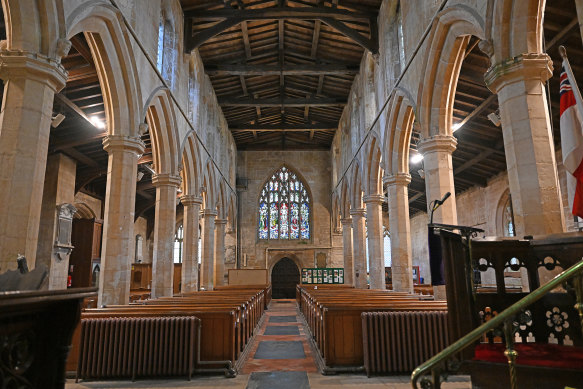
Inside the church where Matthew Flinders will now be buried. Credit: Toby Roberts
It was a particularly exciting find for archaeologists because Flinders’ grandson, Flinders Petrie, is considered the father of archaeology for his pioneering work as an Egyptologist.
“I remember we had been telling everybody the chances of finding him were remote. But we found him,” Wass said. “It is fitting that his last voyage will be back to the village of Donington where he grew up. We are pleased to be playing our part in his last journey.”
At a time when Australia’s colonial history is fiercely debated and contested, Flinders has so far avoided the statue-desecrating campaign targeted at his predecessors and contemporaries including James Cook, Angus McMillan, John Batman, Robert O’Hara Burke and William Wills as agents of imperialism. Part of that is because of his relationship with an Aboriginal man called Bungaree – notably the first person ever to be described as an “Australian”.
The pair first met on a 60-day round trip to Norfolk Island on the HMS Reliance, where Flinders was so impressed with Bungaree’s intuition and bravery that the following year he took him on a coastal survey voyage.
Despite language barriers, Bungaree, a brilliant diplomat, quickly ascertained the wishes of the coastal Aboriginal groups they encountered and Flinders used him on his greatest voyage, the circumnavigation of Australia in the Investigator, from 1802 to 1803.
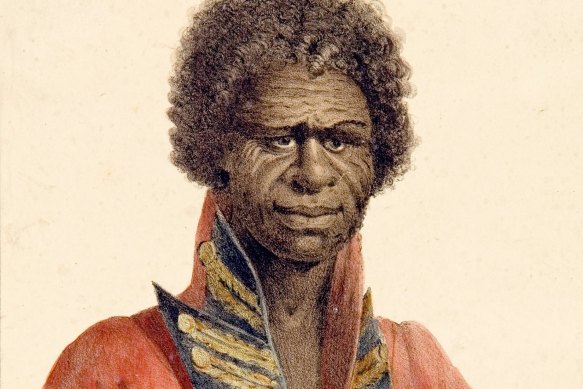
Bungaree circumnavigated Australia with Matthew Flinders and was declared by Governor Macquarie “chief of the Broken Bay tribe” in 1815.Credit: Australian Museum
Gillian Dooley, an honorary associate professor in English literature at Flinders University and a scholar of the explorer’s writings, said Flinders was always driven by his duty.
“He was not being a combatant, he saw himself as part of an international effort to explore the world to find out scientifically what was going on,” she said.
She said he wrote about the Aboriginal population with humanity and had several differing encounters along the way, including hostile interactions. In what is now the Northern Territory, one of his men was speared and the group undertook a revenge. Flinders was furious with his men for having disobeyed his orders.
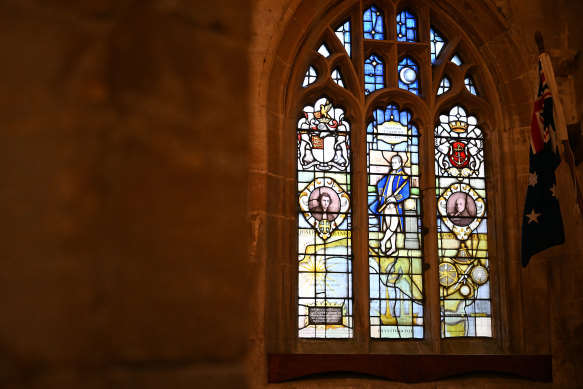
The stained-glass window tribute to Flinders, gifted by the Australian government and the states 40 years ago inside the church at Donington.Credit: Toby Roberts
“I don’t think there’s any denying that he kind of regarded European civilisation, somewhat modern more advanced and more superior to Aboriginal civilisation,” Dooley says. “But he never denied the humanity of these people, you know. And he tried to get his crew to behave properly.”
Organisers are hoping descendants of Bungaree, who live in regional NSW, can attend the funeral if a donor can be found, alongside naval top brass from the UK and Australia, state governors and diplomats.
Loading
So too will Alan James, a retired geography teacher who has lived next door to St Mary’s for 50 years and is regarded as the local guru on all things Flinders. Within the church is a collection of his photographs of Flinders monuments taken from Australia during his eight trips Down Under.
“Over the years, we have met so many Australians who have come to Donington and in turn invited me and my wife to visit them,” said James, who just celebrated his 90th birthday. “We’ve stayed and travelled all over with them. I guess you could say Matthew Flinders has changed my life, really.”
The pages of the church guestbook, going back years, is full of names of Australian visitors, all of whom have popped into Donington to pay homage. More than 300 people will attend the funeral, but organisers have realised they’re oversubscribed and organised a ballot for attendees who aren’t family or dignitaries.
Paul Redgate, a councillor from the South Holland District Council, says bringing Flinders home represented an opportunity to properly re-evaluate the man and his achievements.
“We’re talking about one of the greatest underrated explorers of his time,” he says. “To bring him back home … for people of Australia and hopefully the rest of the area, it’s a chance to come and see [and] learn about the man and what he did.
“It puts us on the map, it really does.”
Get a note directly from our foreign correspondents on what’s making headlines around the world. Sign up for the weekly What in the World newsletter here.









 Add Category
Add Category